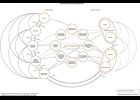Sobre a Casa da Cor – Entrevista com Philippe Henry
In this interview, Philippe Henry talks about himself, his intellectual formation, his intense friendship with Vilém Flusser, Karl Gerstner, Louis Bec and Gottfried Jäger, but above all about the cultural and philosophical significance of colour and the project of the Casa da Cor. The most salient philosophical attribute of colour is what Henry calls the “spectral continuum”, a notion that was also central to Flusser’s and Karl Gerstner’s understanding of colour. Colours project a fluid borderless world. Henry discusses at length the importance of Gerstner’s and Goethe’s colour theory and their criticism of Newton. In early 1987, Henry got to know Flusser through a student of FAAP (Fundação Armando Alvares Penteado). He visited Flusser several times in Robion that with the time became a kind of second headquarter of the Casa da Cor. After the failure of the project in Brazil in late 1989, Flusser and some friends, among them Jean Digne, attempted to transfer it to France. Heny also speaks about the planned journal “Revista da Casa da Cor” for which Flusser had written a few texts. Unfortunately, both projects were not realized. He concludes the interview by referring to Flusser’s attempt to move beyond physics and physiology in order to develop a cultural colour code: “Therefore, behind a new Color Code, there should always be a Cultural Theory of Colors. That was the task of the Casa da Cor. And it still is.”
Letters / From a Universe in Colors toward a Color Universe
The letter exchange between Vilém Flusser and Philippe Henry covers a period of about two-years, from July 1987 to November 1989 and deals mainly with the organization of the project of the House of Colour in São Paulo. Henry and his wife visited Flusser in Robion and met Edith and Vilém Flusser on several occasions in Brazil. The letters were accompanied by texts related to the project, both by Flusser and Henry, who considered Flusser a teacher and a source of inspiration. In “From a Universe in Colors toward a Color Universe”, Henry discusses different understandings of colour, from Newton’s prism to modern biology, and how our understanding of colour has shifted.
Colourful Dialogue: Vilém Flusser, Karl Gerstner and the Casa da Cor
Casa da Cor connected Vilém Flusser with an important interlocutor: Karl Gerstner. Gerstner’s systems-based approach was laid out in his book Designing Programmes: Instead of Solutions for Problems, Programmes for Solutions (1964). He was involved in New Tendencies, the 1960s Zagreb-based group that saw research and the computer as a medium for artistic innovation, and he was included in landmark exhibitions like The Responsive Eye (1965) at the Museum of Modern Art in New York and documenta 4 (1968). Flusser and Gerstner discussed developing a denotative color code and creating a three-dimensional color space, called Colorarium, that would follow precedents like Kandinsky’s The Yellow Sound, composer Ivan Wyschengradsky’s audition colorée, or Le Corbusier’s Poème électronique (1958), as well as Gerstner’s earlier environments made with televisions, Plexiglass spheres, and acrylic-on-polyester reliefs. Neither the Colorarium nor the color code were realized, but they were theorized in Flusser’s writings: “On Science III” (1988) in Artforum mentioned Casa da Cor and asked, “Could a color code become a sort of universal Esperanto, complementing or even substituting for spoken and written language?”
From Abstraction to Concretion: A Brief Overview of the Exhibition Project “BODENLOS_Vilém Flusser and the Arts”
We have attempted a mise-en-scène of Flusser’s thinking in museum settings, applying the techniques of exhibition-making to produce a space to encounter Flusser anew in all his multifarious and passionate contradictions. Flusser emerges here as an irrepressible social actor with proto-curatorial, perhaps even meta-artistic agendas.
